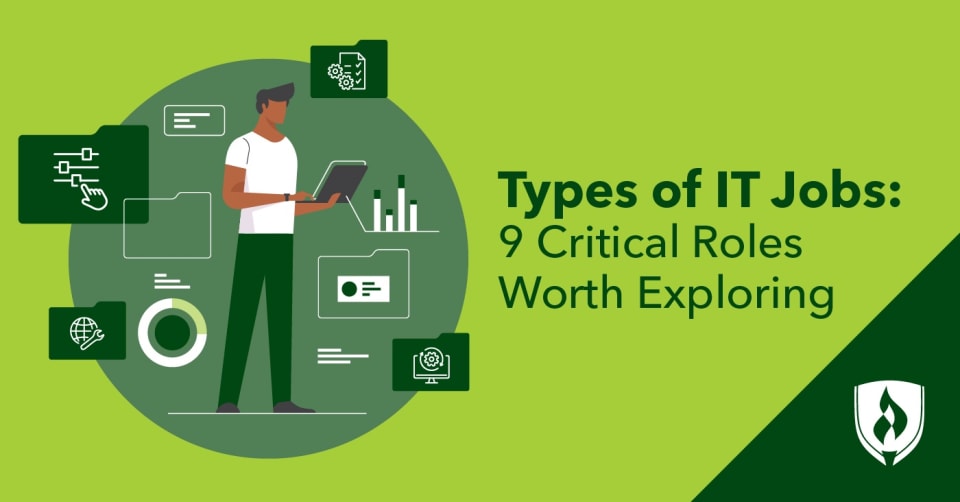
You’re the go-to person in your family whenever someone has a question about their smartphone or trouble with their laptop. Growing up, you loved taking a peek inside your old desktop computer’s tower casing, staring in awe of the futuristic-looking internal components and wondering what each does. Computers have interested you since childhood, and that fascination has not faded as you’ve grown older.
Now that you’re beginning to explore your potential career options, you might be strongly considering turning your interest in computers and technology into a viable career path. The good news is that there are a lot of options when it comes to information technology careers—the only challenge may be finding the right path for you. To help you get a better understanding of what’s out there, we’ll break down different types of IT job categories and then explore the details of nine common roles in IT. Maybe you're wondering "what does IT do?" Read more in our other article here.
Types of IT jobs: Common focus areas
Information technology is a broad subject that houses a lot of specialized roles and expertise. These can be broken down into a few sub-groups:
- Cyber Security: This area focuses on keeping the data of organizations and users secure, as well as the preventative measures taken to reduce harm in the event of a breach.
- Software development: This programming-focused branch of IT revolves around building or modifying software applications to meet users’ needs.
- IT infrastructure: This focus area refers to the design, planning and implementation of IT-related hardware, usually done on an organization-wide scale.
- IT support: This refers to the professionals who assist end users (or other IT support specialists) with day-to-day technical issues.
- Data management:Professionals in this area focus their work on the design of structured database systems, creating data-loss contingency plans and the analysis of gathered data.
It should be noted that the dividing lines between these focus areas aren’t always clear-cut, and many roles in IT may have significant overlap with multiple categories. For example, the programming skills used in software development can be applied to data analysis roles and knowledge of cyber security best practices is a key consideration for IT infrastructure planning.
IT jobs: A closer look at 9 common IT roles
Now that we’ve covered some of the broader focus areas found under the domain of information technology, let’s dive into some of the specific job roles profiled by the Bureau of Labor Statistics that you could potentially find yourself in as an IT professional.
1. Software developer
Software developers (as well as the closely related quality assurance analysts and testers) are the tech professionals tasked with creating and modifying computer programs. They use a mix of programming and logical planning skills to write the code guiding how these programs work. Some may focus more on writing individual code components while others focus their time on the big picture work like mapping the needs of users and determining the core functionality needed to meet them. Additionally, they may spend time troubleshooting code and performing regular maintenance of a program. This career requires a mix of coding skills, logical planning ability, collaboration skills and creativity.
Typical duties: 1
- Analyzing user needs and creating computer programs that meet those needs
- Analyzing and recommending possible improvements or fixes to existing programs and systems
- Planning and mapping out how individual pieces of an application or system will work together
- Developing and implementing testing plans to ensure functionality
- Monitoring and addressing application functionality through maintenance and testing
- Creating reference documentation
Projected employment growth (2020–2030): 22 percent.1
2. Computer network architects
Computer network architects (sometimes called computer network engineers) design and build networks including local area networks (LANs), wide area networks (WANs) and Intranets. These sorts of networks might be small connections between offices or large enterprise-scale networks. Someone in this role also works on any issues that arise within the network and anticipate future networking needs.
Typical duties:1
- Creating plans and layouts for data communication networks
- Communicating plans and network needs to management or other stakeholders
- Assessing security needs and creating plans to address them
- Upgrading hardware as needed
- Researching new network technologies to determine future needs
Projected employment growth (2020–2030): 5 percent.1
3. Computer support specialists
Computer support specialists are on the front lines of IT as they assist users with a wide variety of day-to-day issues—for example, trouble connecting to Wi-Fi, configuring a new workstation or troubleshooting issues connecting to the new printer. Additionally, they may assist network and systems administrators with larger-scale software or hardware rollouts. They are natural problem solvers and strong communicators who troubleshoot and evaluate computer problems promptly and efficiently, serving a critical role within any organization.
Typical duties:1
- Listening to users’ descriptions of computer problems, asking questions and evaluating their needs
- Walking users through steps to solve their problems
- Setting up and repairing computer equipment and devices
- Training users on how to use computer hardware and software
Projected employment growth (2020–2030): 9 percent.1
4. IT project managers
IT project managers play a unique role in this field. They’re responsible for the planning, initiation and execution of complex IT projects and initiatives. To do this, they must serve as a bridge between the technical teams carrying out the work and the organizational stakeholders setting the overall vision and goals of a project. They help both sides understand the potential hurdles facing a project, create overall project plans for how this work will be completed and hold teams accountable for meeting deadlines and budgets. IT project managers have a strong blend of technical knowledge, organization ability and planning, problem-solving and communication skills.
Typical duties: 2
- Meeting with organizational stakeholders to determine scope and timing of IT projects
- Working with technical teams to identify potential barriers or issues and determining options for how to overcome them
- Conducting regular check-ins to monitor project progress and address unexpected issues
- Creating overall IT project work rollout plans
- Conferring with technical teams to identify what resources are needed for a project
Projected employment growth (2020–2030): 7–10 percent.2
5. Web developers
Web developers and digital designers design, create and maintain websites. This role often falls into one of three categories: back-end developers, who work mainly with the technical construction of the website, front-end developers, who are responsible for the look and design of a website, and webmasters, who maintain and update websites—though many of these roles may blend together depending on the organization. This career calls on excellent coding, creativity and communication skills in order to create websites that meet the needs of users and organizations alike.
Typical duties: 1
- Meeting with clients and assessing their website needs
- Creating and testing web applications
- Writing code for the website
- Collaborating with website stakeholder teams
- Creating user-friendly, functional and accessible layouts
- Monitoring site traffic or other key performance metrics
Projected employment growth (2020–2030): 13 percent.1
6. Information security analysts
A constantly evolving and critical position, an information security analyst protects an organization’s network and systems from security breaches and the potential fallout from them. These analysts work to create disaster recovery plans, conduct assessments of security threats, create plans remedying potential threats and keep a close eye on new and emerging threats in the industry. This role requires extensive knowledge of how hardware and software interface, their potential weaknesses and the ability to drive proactive change within an organization to address information security concerns.
Typical duties:1
- Monitoring for security breaches or potential weaknesses
- Overseeing the organization-wide implementation of protective measures such as firewalls and antivirus programs
- Creating reports documenting any security breaches and providing guidance on what can be done to prevent them going forward
- Testing for potential vulnerabilities in systems
- Developing security best practices for an organization and creating training documentation
Projected employment growth (2020–2030): 33 percent.1
7. Computer systems analysts
Computer systems analysts, or systems architects, create new systems and procedures to optimize an organization’s computer needs. Computer systems analysts often have both a sophisticated understanding of IT and a strong background of industry-specific knowledge like healthcare, finance or marketing. For example, in a healthcare setting, a computer systems analyst may be tasked with modifying or designing a system used for storing and sharing patient medical records. That information may require special legal considerations, so analysts who understand the laws governing patient information and how this system will be used by providers are critically important.
Typical duties:1
- Working alongside managers and other subject matter experts to assess an organization’s IT needs
- Researching and analyzing the potential benefits and drawbacks of new technologies
- Choosing and configuring new hardware and software to meet organizational needs
- Managing the installation of new computer systems
- Training end users and creating instruction manuals or other key documentation
Projected employment growth (2020–2030): 7 percent.1
8. Database administrators and architects
Businesses and organizations generate and collect a massive amount of data in order to fuel their daily operations. Database administrators are the professionals who help store, secure and organize that data. They are tasked with building databases that logically store information in a way that works well with the systems that may access this information. They may also be responsible for data recovery efforts and creating data backups.
Typical duties:1
- Creating back-ups of data and recovering lost data
- Ensuring user permissions for data use are valid and up to date
- Merging existing databases into new databases
- Identifying user needs in order to create new databases
- Maintaining proper function of all databases
Projected employment growth (2020–2030): 8 percent.1
9. Network and computer systems administrators
Network and computer systems administrators are responsible for the upkeep of an organization’s networks. While a computer network architect’s work is typically more focused on designing an organization’s network, a network system administrator is more responsible for the day-to-day operation of those networks and ensuring they’re working as intended. Network systems administrators may provide direct user support or supervise computer support specialists. This role is often a logical next step in the career ladder for user support specialists, and their work typically focuses on a larger scale or more complex network issues.
Typical duties:1
- Making upgrades and repairs to networks
- Securing network and computer systems
- Adding users to a network
- Training users on hardware and software
- Troubleshooting user problems
Projected employment growth (2020–2030): 5 percent.1
Ready to take the next step toward an IT career?
Launching a career in information technology might just be the perfect move for you. IT infrastructure and the professionals associated with it are a critical piece of the puzzle for a huge variety of businesses and organizations, and that’s unlikely to change any time soon. Check out some additional computer careers for self-proclaimed "tech geeks".
Looking for some signs you should be working in tech? Read those here.
Now that you’ve learned more about some of the different types of IT jobs out there, are you ready to equip yourself with the education needed to get an IT career started? No matter your education or existing career experience, the Rasmussen University School of Technology offers a variety of online education programs that can help set you up for success. Visit the School of Technology programs page to learn more about these offerings.
Related Articles:
- What Is an IT Project Manager? Breaking Down This Unique Tech Career
- Exploring Top IT Job Titles for Every Stage of Your Career
1Bureau of Labor Statistics, U.S. Department of Labor, Occupational Outlook Handbook, [accessed February 2022] www.bls.gov/ooh/. Information represents national, averaged data for the occupations listed and includes workers at all levels of education and experience. This data does not represent starting salaries. Employment conditions in your area may vary.
2Bureau of Labor Statistics, U.S. Department of Labor, Occupational Employment Statistics, [accessed February 2022] www.bls.gov/oes/. Information represents national, averaged data for the occupations listed and includes workers at all levels of education and experience. This data does not represent starting salaries. Employment conditions in your area may vary. Salary information and job growth projection for IT project managers correspond with BLS occupation data for “Computer Occupations, all other.”




